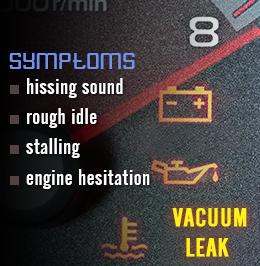
Idling MythIt is a myth that restarting an engine uses more gas than idling. An engine restart consumes fuel approximately equal to 10 seconds of idling.
Car lovers would never like their beloved automobiles to conk out suddenly. (and yes, for no reason when you actually need them the most!) And so, the car devotees do take real good care of their babies to keep them all up and running. But what all needs to be carefully looked at, noticed, checked, felt, experienced, or heard, besides the routine issues during a car servicing?
There is one thing that usually slips our mind, but has the capacity to end up in some real bad trouble. Vacuum leaks are understood to be one of the biggest reasons for engine performance issues. Since it can harm the car engine, it is better to find out if your car has such a problem, and to fix it in time. Here is a list of the common symptoms of a vacuum leak in a car.
Symptoms of a Vacuum Leak
1. Hissing SoundMechanics have a ear for this particular noise that a car with vacuum leak makes. It resembles the sound of whistling. A little difficult to hear normally, you may catch it if you listen keenly. It is a high-pitch sound, which you might have even heard before, not knowing the reasons.
2. Rough Engine IdleA mostly definite symptom of a vacuum leak is a rough engine idle, also stalling at times. Idle speed is the rotational speed (measured in revolutions per minute of the crankshaft, or RPM) at which the engine runs. If this idling speed is too fast, make sure to check for any vacuum outflow.
3. Engine HesitationIf you have observed that the engine misfires, or stumbles while running at a considerably fast speed, it is a cause for concern. This hesitation is experienced mostly while acceleration, as the vacuum pressure is markedly high. This causes the engine to stumble or hesitate.
4. Poor AccelerationAnother hint towards a possible vacuum leak is a weak engine. You might have noticed that the car fails to easily pick up speed, despite giving it gas. This indicates reduced engine power, another common symptom of a leakage. Vacuum escape pulls down the overall force and pressure generated during combustion.
5. Imprecise Transmission ShiftingA part of the operational power required for shifting gears comes from the engine vacuum. A vacuum leak can make the transmission shifting points weak and imprecise.
6. Hard StartIt can hinder the functioning of the carburetor, or the fuel injection system, or both. The change in the optimal pressure and vacuum in the engine causes difficulties in starting the engine.
Air-Fuel RatioThe air required for combustion is drawn with the help of the butterfly valve, which is partially open. It creates a vacuum, which is utilized for various ancillary devices. Remember that, most of the cases of vacuum leaks are initially ignored, as they are misinterpreted to be ignition or fuel problems. A vacuum leakage is very harmful for the engine, as it allows ample air to enter the engine and disturb the air-fuel ratio. Vacuum leaks primarily impact the vacuum pressure in the internal combustion engine. They cause a lean condition. A tiny leak can mar the engine’s performance. It may turn the ‘Check Engine’ light on too.
The Mass Airflow Sensor (MAF) measures the inflow of air. The leak is downstream of the MAF. This results into more consumption of air by the engine than what is measured, giving an incorrect reading. So, the normal 14.7:1 air-to-gasoline ratio is raised, resulting in the engine running leaner (or consuming low fuel than the ratio) than it would normally. Leaks are not necessarily developed in the engine only. They can be found elsewhere too, depending on the type of engine.
Vacuum Leak TestChecking for vacuum leaks and identifying them is a difficult task. Visual checks of the carburetor, vacuum lines, throttle body, and looking for any open ports or exposed brass nozzles may show detached vacuum lines. Vacuum leaks can be checked by using propane gas too. With the engine on, spraying propane gas over doubtful points in the manifold intake area may make the car engine come to a stop. That confirms the exact location of the leak. It is definitely not advisable for anyone to experiment with it though. Reporting the troubles to an expert mechanic is a better and safer option anytime.